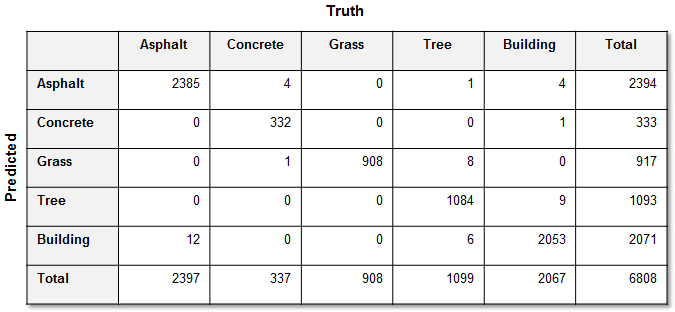The OmissionError function method returns the errors of omission. The result is an array with one value per class.
Errors of omission represent the fraction of values that belong to a class but were predicted to be in a different class. They are a measure of false negatives. Errors of omission are shown in the columns of the confusion matrix, except for the values along the main diagonal.
In the example confusion matrix, the errors of omission are computed as follows:
Asphalt: (0 + 0 + 0 + 12) / 2397 = 0.0050
Concrete: (4 + 1 + 0 + 0) / 337 = 0.0148
Grass: (0 + 0 + 0 + 0) / 908 = 0.000
Tree: (1 + 0 + 8 + 6) / 1099 = 0.0136
Building: (4 + 1 + 0 + 9) / 2067 = 0.0068

Example
The code example below evaluates classifications using a confusion matrix.
PRO EvaluateClassificationUsingConfusionMatrix
COMPILE_OPT IDL2
e = ENVI()
File = Filepath('qb_boulder_msi', Subdir=['data'], $
Root_Dir=e.Root_Dir)
Raster = e.OpenRaster(File)
File2 = Filepath('qb_boulder_roi.xml', Subdir=['data'], $
Root_Dir=e.Root_Dir)
Rois = envi.OpenROI(roiFile)
StatTask = ENVITask('ROIStatistics')
StatTask.INPUT_RASTER = Raster
StatTask.INPUT_ROI = Rois
StatTask.Execute
Task = ENVITask('MahalanobisDistanceClassification')
Task.INPUT_RASTER = Raster
Task.COVARIANCE = StatTask.Covariance
Task.MEAN = StatTask.Mean
Task.CLASS_PIXEL_COUNT = StatTask.Roi_Pixel_Count
Task.CLASS_NAMES = [Rois[0].name, Rois[1].name, Rois[2].name]
Task.CLASS_COLORS = [[0,0,255], [0,255,0], [255,0,0]]
Task.Execute
ClassRaster = Task.OUTPUT_RASTER
View = e.GetView()
Layer = View.CreateLayer(ClassRaster)
envi.Data.Add, ClassRaster
ConfusionMatrix = ENVICalculateConfusionMatrixFromRaster(ClassRaster, Rois)
Print, 'Confusion Matrix:'
Print, ConfusionMatrix.Confusion_Matrix
Print, 'Errors of commission: '
Print, Transpose([[ConfusionMatrix.Column_Names+': '], [(ConfusionMatrix.CommissionError()).ToString()]])
Print, 'Errors of omission: '
Print, Transpose([[ConfusionMatrix.Column_Names+': '], [(ConfusionMatrix.OmissionError()).ToString()]])
Print, 'Overall accuracy: ', ConfusionMatrix.Accuracy()
END
Syntax
Result = ENVIConfusionMatrix.OmissionError([, ERROR=variable])
Return Value
This function method returns the errors of omission from the confusion matrix.
Arguments
None
Keywords
ERROR (optional)
Set this keyword to a named variable that will contain any error message issued during execution of this routine. If no error occurs, the ERROR variable will be set to a null string (''). If an error occurs and the routine is a function, then the function result will be undefined.
When this keyword is not set and an error occurs, ENVI returns to the caller and execution halts. In this case, the error message is contained within !ERROR_STATE and can be caught using IDL's CATCH routine. See IDL Help for more information on !ERROR_STATE and CATCH.
See Manage Errors for more information on error handling in ENVI programming.
Version History
See Also
ENVIConfusionMatrix